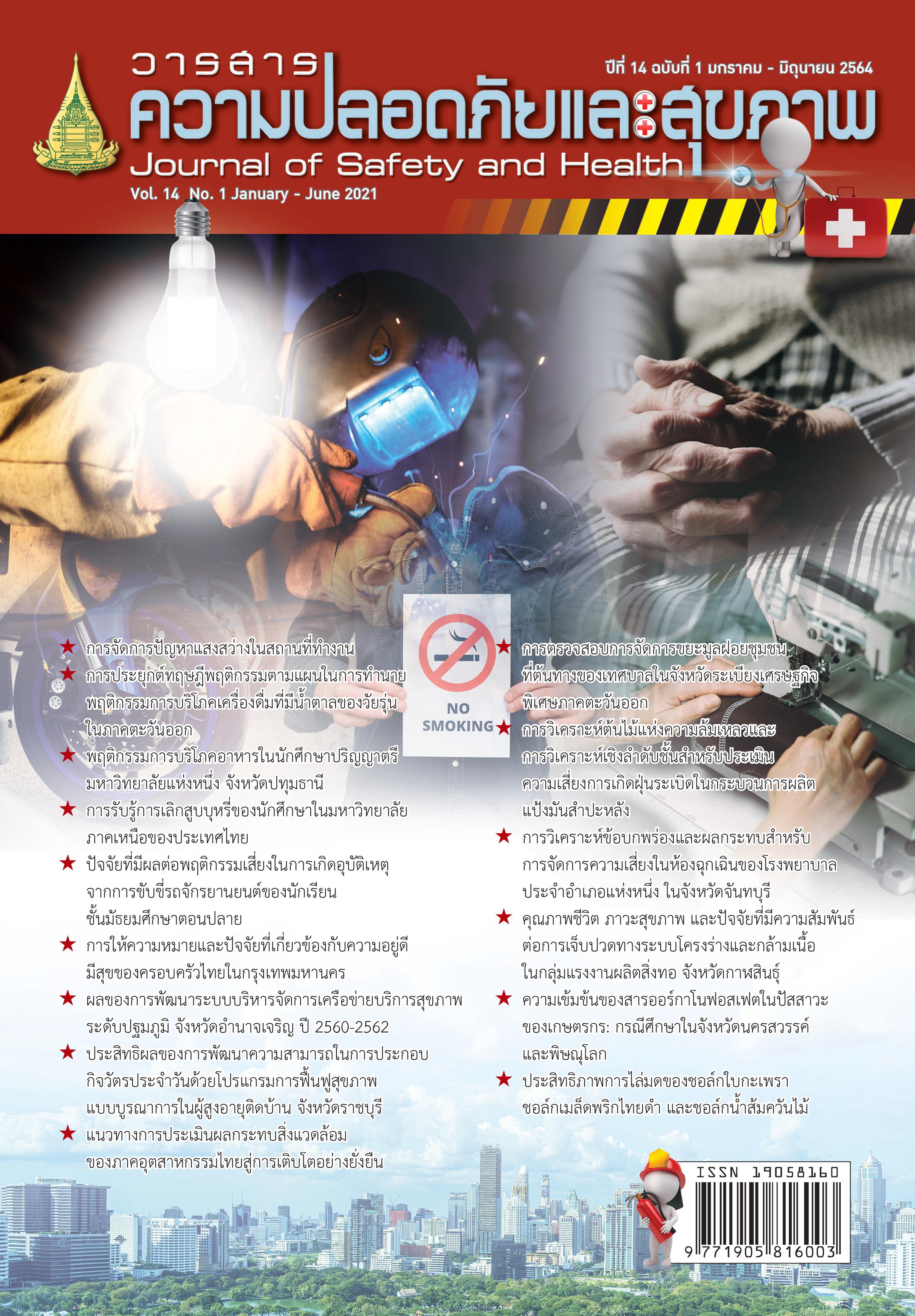ความเข้มข้นของสารออร์กาโนฟอสเฟตในปัสสาวะของเกษตรกรในประเทศไทย
Main Article Content
บทคัดย่อ
สารกำจัดศัตรูพืชสามารถช่วยกำจัดศัตรูพืชต่างๆได้ แต่ก็มีผลกระทบต่อสิ่งแวดล้อมและสุขภาพของมนุษย์ การศึกษาครั้งนี้มีวัตถุประสงค์เพื่อประเมินการได้รับสัมผัสกับสารกำจัดศัตรูพืชกลุ่มออร์กาโนฟอสเฟตจากเกษตรกร 216 คน (เกษตรกรปลูกข้าว 51 คน เกษตรกรปลูกผัก 37 คน เกษตรกรปลูกข้าวและอ้อย 70 คน และเกษตรกรปลูกข้าวและผัก 38 คน) ในจังหวัดนครสวรรค์และพิษณุโลก และตรวจวัดความเข้มข้นของเมตาบอไลต์ของสารกำจัดศัตรูพืชในกลุ่มออร์กาโนฟอสเฟตในปัสสาวะ โดยใช้เครื่องแก๊สโครมาโทกราฟี-แมสสเปกโทมิเตอร์(GC-MS) ในการวิเคราะห์ตัวอย่าง ผลการศึกษา พบว่า ขีดจำกัดการตรวจจับสำหรับวิธีการวิเคราะห์อยู่ในช่วง 4.46-6.73 นาโนกรัมต่อมิลลิลิตร ค่าร้อยละการกลับคืนของสารไดอัลคิลฟอสเฟต (DAP) แต่สารที่ความเข้มข้น 2.5-50 นาโนกรัมต่อมิลลิลิตร อยู่ในช่วง 94.29-105.01% เกษตรกรทุกคนมีสาร DAP ในปัสสาวะอย่างน้อยหนึ่งสาร สาร DAP ที่ตรวจพบอยู่ในช่วง 0-94.3% โดยค่ามัธยฐานของระดับสารไดอัลคิลฟอสเฟตรวม (∑DAPs) มีค่าสูงสุดในกลุ่มเกษตรกรปลูกผัก อาการแสดงหลังจากฉีดพ่นสารกำจัดศัตรูพืชสูงสุด 3 อันดับแรก ได้แก่ เหงื่อออก เวียนศีรษะ และปวดศีรษะ ตามลำดับ และพบความสัมพันธ์ระหว่าง ∑DAPs กับอาการตาพร่ามัว (p=0.011) ในการศึกษานี้การตรวจพบสาร DAP อยู่ในระดับสูง ดังนั้นการส่งเสริมความรู้และความเข้าใจเกี่ยวกับความปลอดภัยในการใช้อุปกรณ์ป้องกันอันตรายส่วนบุคคลและการใช้สารกำจัดศัตรูพืชอย่างเหมาะสมจึงเป็นสิ่งจำเป็นในการตรวจติดตามและการเฝ้าระวัง
Article Details
Journal of Safety and Health is licensed under a Creative Commons Attribution-NonCommercial-NoDerivatives 4.0 International (CC BY-NC-ND 4.0) licence, unless otherwise stated.
เอกสารอ้างอิง
info/info.php?FileID=88.
กองโรคจากการประกอบอาชีพและสิ่งแวดล้อม. รายงานสถานการณ์โรคและภัยสุขภาพจากการประกอบ
อาชีพและสิ่งแวดล้อมปี 2561. สืบค้นเมื่อ 9 เม.ย. 2563, จากhttp://envocc.ddc.moph.go.th/ uploads/situation2/2561/2561_01_envocc_situation.pdf
กองโรคจากการประกอบอาชีพและสิ่งแวดล้อม. โรคจากสารเคมีกำจัดศัตรูพืช. สืบค้นเมื่อ 9 เม.ย. 2563. จาก
http://envocc.ddc.moph.go.th/contents/view/72.
ภาควิชาเภสัชวิทยา คณะสัตวแพทยศาสตร์. สารกำจัดศัตรูพืช. สืบค้นเมื่อ 9 เม.ย. 2563. จาก
http://www.pharmaco.vet.ku.ac.th/pdf_file/Pesticide_20161020.pdf.
สำนักงานเศรษฐกิจการเกษตร. (2563). ข้อมูลเศรษฐกิจการเกษตร. สืบค้นเมื่อ 10 ส.ค. 2562.จาก
http://www.oae.go.th/.
Daniel, W.W. & Cross, C.L. (2013). Biostatistics : a foundation for analysis in the health
sciences (10th ed.). Hoboken: John Wiley & Sons, Inc.
Hanchenlaksh, C., Povey, A., O’Brien, S., de Vocht, F. (2011). Urinary DAP metabolite levels
in Thai farmers and their families and exposure to pesticides from agricultural pesticide
spraying. Occup Environ Med, 68,625-627.
Harnpicharnchai, K., Chaiear, N., & Charerntanyarak, L. (2013). Residues of organophosphate
pesticides used in vegetable cultivation in ambient air, subdistrict, Khon
Kaen, Thailand. Assessment of organophosphate pesticides in the environment,
44(6),1088-1097.
Hongsibsong, S., Kerdnoi, T., Polyiem, W., Patarasiriwong, V., & Patarasiriwong, T. (2015) Organophosphate Pesticide Exposure of Farmers in Chiang Mai Province, Northern
Thailand. International Conference on Advances in Environment Research, 87,
73-76.
Hongsibsong, S., Sittitoon, N., & Sapbamrer, R. (2017) Association of health symptoms with
low-level exposure to organophosphates, DNA damage, AChE activity, and
occupational knowledge and practice among rice, corn, and double-crop farmers.
Journal of Occupational Health, 59, 165-176.
Kongtip, P., Nangkongnab, N., Mahaboonpeeti, R., Bootskeaw, S., Batsungnoen, K., Hanchenlaksh, C., et al. (2018). Differences among Thai agricultural worker health,
working conditions and pesticide use by farm type. Annals of Work Exposures and
Health, 62(2), 167-181.
National Statistical Office Thailand. (2020). Summary of the labor force survey in Thailand.
Retrieved April 9, 2020, from http://www.nso.go.th/sites/2014en/Survey/social/
labour/LaborForce/2020/february_2020.pdf
Panuwet, P., Prapamontol, T., Chantara, S., Thavornyuthikarn, P., Montesano, M.A.,
Whitehead Jr, W., et al. (2008). Concentrations of urinary pesticide metabolites in
small-scale farmers in Chiang Mai Province, Thailand. Science of The Total
Environment, 407(1),655-668.
Prapamontol, T., Sutan, K., Laoyang, S., Hongsibsong, S., Lee, G., Yano, Y., et al. (2014).
Cross validation of gas chromatography-flame photometric detection and gas
chromatography–mass spectrometry methods for measuring dialkylphosphate
metabolites of organophosphate pesticides in human urine. International Journal of
Hygiene and Environmental Health, 217, 554-566.
Rohitrattana, J., Siriwong, W., Tunsaringkarn, T., Panuwet, P., Ryan, P.B., Barr, D.B., et al.
(2014). Organophosphate Pesticide Exposure in School-Aged Children Living in Rice
and Aquacultural Farming Regions of Thailand. Journal of Agromedicine, 19(4),
406-416.
Sapbamrer, R., Hongsibsong, S., & Kerdnoi, T. (2017). Urinary dialkylphosphate metabolites
and health symptoms among farmers in Thailand. Environmental & Occupational
Health, 72(3),145-152.
Wongta, A., Sawarng, N., Tongchai, P., Sutan, K., Kerdnoi, T., Prapamontol, T., et al. (2018).
The pesticide exposure of people living in agricultural community, Northern Thailand.
Journal of Toxicology, 1-7.


